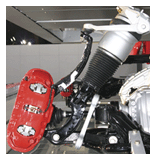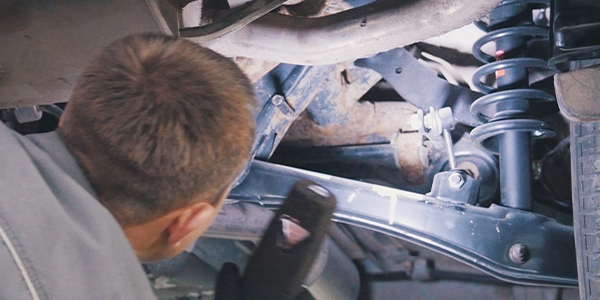The primary purpose of a shock absorber (or strut) is to control suspension movement. This is done by a piston moving fluid through a series of valves within the shock or strut housing. The valves control the damping rate of the shock throughout the travel of the piston. The damping characteristics are engineered to complement the suspension of each vehicle. Most shocks or struts are anything but linear in their damping effect. There is usually less resistance to movement in the jounce mode (wheel moving upward) than in rebound. This helps to improve the ride quality over bumps, while controlling the oscillations that would occur during rebound if the shock did not “tighten up.”
The damping effect may also be less during slow, short movements of the shock shaft. With larger or faster movements away from center, the resistance to movement will increase. This allows a smooth ride over small bumps, while maintaining ride control over larger bumps. The damping effect is crucial to maintaining vehicle control, especially during evasive maneuvers. The shock helps keep the wheel on the road. The stickiest tire in the world won’t steer or stop a car if it’s in the air.
The shock or strut not only controls suspension movements over bumps, but also as the body of the car dives during braking, squats during acceleration and rolls during turns. A shock cannot add to the roll stiffness of the suspension as a sway bar does, but it can add to roll stiffness during transient maneuvers such as lane changes. On a long turn, such as a freeway off ramp, the car will roll and stay at that angle as long as the weight transfer remains the same. This is because of the long period of time the car remains in the turn. But during a quick change of direction, the shocks will resist a quick change of suspension movement, thereby momentarily increasing roll stiffness and vehicle  stability. Worn shocks or struts can cause loss of control in corners and increase stopping distances. The most common reasons for replacing struts or shocks are that they are worn (too soft and bouncy) or leaking. A bouncy ride may not even be noticed by the driver, as shock and strut wear is generally slow, happening over tens of thousands of miles of driving. However, a bouncy ride or a leak is not the only way a strut can fail. Since the strut itself generally replaces the upper control arm, it must also bear some of the suspension’s lateral load. Struts can become so worn out that they actually bind. Over the years, I have seen several cars with this problem to the extent that pushing down or pulling up on the affected corner of the car would cause the body to stay at whatever height it was at when released. Needless to say, this condition made for some interesting lane changes!
stability. Worn shocks or struts can cause loss of control in corners and increase stopping distances. The most common reasons for replacing struts or shocks are that they are worn (too soft and bouncy) or leaking. A bouncy ride may not even be noticed by the driver, as shock and strut wear is generally slow, happening over tens of thousands of miles of driving. However, a bouncy ride or a leak is not the only way a strut can fail. Since the strut itself generally replaces the upper control arm, it must also bear some of the suspension’s lateral load. Struts can become so worn out that they actually bind. Over the years, I have seen several cars with this problem to the extent that pushing down or pulling up on the affected corner of the car would cause the body to stay at whatever height it was at when released. Needless to say, this condition made for some interesting lane changes!
While a strut that is leaking, bent or binding is in obvious need of replacement, there are a few other tell-tale signs that a strut or shock is excessively worn. Damaged chrome plating on the shaft will eventually cause seal damage and leaks. A dented or otherwise physically damaged strut should be replaced due to the potential damage that the piston may incur on its way past a dent.
Suspension jounce or rebound bumpers showing signs of excessive use may indicate a weak shock. Weak shocks or struts should also be suspected if tires show signs of cupping. Worn bushings or mounting hardware should be replaced, too. A customer may also complain of a vibration or shudder after hitting a bump. A severely worn shock or strut can cause quite a vibration as the wheel literally bounces down the road.
While there is no hard and fast rule for determining just how much wear is too much when it comes to shocks and struts, if the proverbial “bounce test” results in a vehicle making more than two oscillations, it might be time to recommend replacement of the affected units.
An upgrade from a standard oil strut or shock to a gas pressure-type is another way to increase profits. This type of upgrade is most often appreciated by the sports car enthusiast or off-roading four-wheel-driver, but many others may want the benefits of gas shocks. Gas pressure on the oil within the shock helps prevent foaming and aeration of the fluid. Just like air in a brake line, foam in a shock renders it soft and ineffective. While gas shocks are becoming more popular as OE equipment, there is still room to upgrade.
Remember what shocks do? They dampen suspension movement. What happens to that energy? The same as with brakes — it gets turned into heat. Therefore, an SUV, truck or vehicle used for towing may benefit from a shock with a larger piston. The larger shock will run cooler and last longer in heavy-duty applications.
With struts having been around for so long now, it’s easy to forget just how dangerous this type of work can be if basic safety rules are not followed. Remember, there is a lot of energy stored in a compressed spring. Casual disregard for their potentially lethal force is foolhardy. Make sure that the spring compressor you are using is adequate for the job you are doing. Some less expensive compressors do not have enough range to completely remove all of the tension of the spring before they run out of travel.
Besides a good spring compressor, some hand tools can make an impossible job possible, or an otherwise difficult job easier. If you are going to do a lot of strut work, it may be worth your while to invest in some tools to make that job easier. Special spanner wrenches to remove the large nut at the top of the strut (for those struts with replaceable cartridges) are available in sets to make nut removal easier. Strut vises, while not absolutely necessary, can hold the strut steady while you’re twisting that large cartridge retaining nut.
Some strut mounting bolts also allow for camber adjustment. Upper mounting plates may allow for caster and/or camber adjustments. Whenever these adjustments are disturbed, you should always check wheel alignment after strut installation. However, marking the bolts or plates before disassembly will get you back in the ball park, ensuring that any adjustments needed will be minimal. Be careful that you don’t damage brake lines, hose or wheel-speed sensors during R&R. Wheel-speed-sensor wiring can be damaged internally without an obvious break in its outer insulation. Some wheel speed sensors sell for more than $200 each. Ouch!
Before shocks are installed on the vehicle, they should be held right side up and stroked several times to purge any air that may have found its way to the wrong side of the piston during shipping. This usually isn’t necessary with the gas pressure types, but it couldn’t hurt.
One more tip on shocks that are often seen on rear-wheel-drive installations where the top of the shock mounts by means of a straight stud through bushings. Oftentimes the nut is seized to the stud so that turning the nut to remove it simply rotates the entire shaft of the shock. These will usually come off with repeated blasts of an impact wrench. If it’s too tight for that, try this. Place the correct size deep socket over the stud and onto the nut. Insert a long extension into the socket. Now rock the extension back and forth (as if shifting a manual transmission from first to second to first.) In less than a minute, the rocking will fatigue the metal and break the stud off below the nut.












